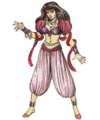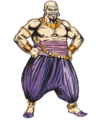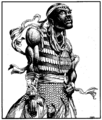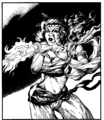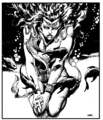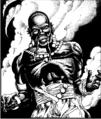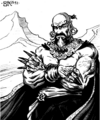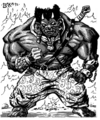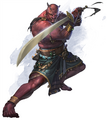Genie
Genies, a term corrupted from the Arabian term "djinni", are mystical spirits originating from Arabic folklore and later getting incorporated into the religion of Islam as something of a grey area between an equivalent to JudeoChristian demons and simply another race of mortals. They are best known for their immense magical powers, which iconically allow them to literally alter reality as they see fit. Because of this, mages have a pretty long tradition of magically stuffing them into small objects (lamps are most iconic, but rings and vases are pretty common too) and compelling them to obey whoever holds their prison. They also tend to be major league dicks, though whether this dickishness is because of the aforementioned "being stuck in a lamp and forced to grant wishes for every yahoo who can get ahold of it" or they got stuffed into a lamp for being a dick tends to vary.
The most common stories involving Genies involve someone setting one free and in return allowing them wishes, generally with a certain amount of mischief in creative interpretation. You rub a bottle, a genie comes out, make a wish and you end up running for your life from a 30 meter tall Nixon as he rampages through your hometown Kaiju Style. Worth noting is that the wish-granting worked very different in the original tales than it does in modern fantasy, in several ways: 1)The number of wishes a given genie offered was not necessarily three; depending on the genie, it could be one wish, infinite wishes, or any number in between. 2) The actual granting of a wish didn't consist of the genie snapping their fingers and magicking your desires into reality, it was just them doing a favor they owed you by mundane means; if for example you wished to be the king/queen of the land, the genie would do something like go and purchase the title from the current ruler. 2i) As such, there was no guarantee that the genie would be able to grant your wish. Genies varied significantly in how powerful they were: one might be able to afford the purchasing of the queen's crown, for example, but another might only be able to get you as high as a baroness.
They're usually pretty good looking, and it's not unheard of for them to have sex with or even marry mortals.
Dungeons & Dragons
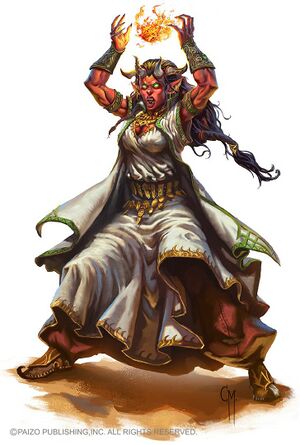
Genies are one of the "big names" for the Elemental Planes; being the most human-like in appearance and intelligence, they present a "face" for interactions both positive and negative that the more primordial elementals lack. There are four species of genie, one for each of the four major elements: Djinn (air), Efreet (fire), Dao (earth), and Marid (water); some editions also have a fifth, the Jann, comprised of all four elements and thus needing to spend most of their time on the Prime Material. Although very different in personality, the various types each share certain traits, including polyamory (except the Jann) and large libidos, vaguely Middle Eastern cultures, and the ability to grant wishes with a laundry list of restrictions (notably, they can't grant wishes for themselves or other genies, and while they can grant one wish a day they can't grant another wish to the same creature until a very long period of time has passed).
Of these four (to five) races, it has always been the Djinn and the Efreet who have stuck out the most in the D&D player's mind. These two races have very clear archetypes; djinni are the "friendly leaning but dangerous if made moody" genies, whilst efreeti are the "obviously evil genies". In comparison, dao tend to boil down to "efreeti with earth powers and a lot more greed for gold and gems", whilst marids tend to boil down to "djinni with water powers, an even more fickle attitude, and a barrowload of extra ego". Jann, being both the weakest type of genie and the one type native to the Prime Material and thus more likely to be met in person on your travels than found in a magic item, come across more as a race of desert nomads with magic than "proper" genies.
In fact, it got to the point that 4e originally left those three races out; it wasn't until an article in Dungeon Magazine #199 that the dao and marids both returned to 4th edition (the Jann could suck it). And they were still pretty much identical to their classic depictions; dao were avaricious, evil, giant earth-genies obsessed with mineral wealth, and marids were arrogant, flamboyant, adventurous water genies who all to the last claimed a noble title. Whether this was deliberate - a lot of the later 4e Dungeon & Dragon magazine articles tended towards bringing back older lore - or was just a sign that the grid-filling nature of D&D genies robs even the best authors of their creativity, who can say?
Al-Qadim, the "Arabian Nights" mini-setting for the Forgotten Realms, placed a lot of emphasis on genies, naturally. It created the "Tasked Genie" designation, a variety of lesser genies specially molded to fulfill certain tasks until they had become entirely new species revolving around that task (specific strains: Administrator, Architect/Builder, Artist, Deceiver, Guardian, Harim Servant, Herdsman, Messenger, Miner, Oathbinder, Slayer, Warmonger and Winemaker). It created the Markeen, or "Genie Double", a genie cursed to be the exact physical replica of a mortal, and it introduced the Sha'ir class; a Wizard variant that drew its powers from the service of a minor allied genie called a gen.
Genies are one of the elementals most likely to produce genasi offspring, though Pathfinder also has a specific "genie-born" hybrid, the Suli.
3.5's Tome of Magic introduced a new breed of genie; the Khayal, a "darkness elemental" genie native to the Plane of Shadow. Master wielders of shadow magic, khayal are distinguished by their dark, dusky-gray skin and their utter-black eyes, which appear more like night-filled holes in their skull than anything human-like. If one can look past that, they otherwise look like slightly taller than average humans. They regard the other elemental genies with varying levels of antipathy, but have an especial hatred for jann. Looking down on all other races, khayal culture revolves around deciving and manipulating them - although they are never anything but scrupulously honest with each other. Tradition holds that anyone who can irrefutably prove they have been lied to by a khayal is owed a single task from that genie in recompense, but they don't always live up to this. They have been known to assist mortals of their own volition, either out of mutual need or due to being impressed at the mortal's deceitfulness, but they display archetypical genie arrogance when they do.
3.5 also gave us the Frostfell sourcebook, and with it, the Qorrashi, who were associated with the Paraelemental Plane of Ice, but they only got an average-size soucebook bestiary-level description, so there's not much to say about them other than that they exist.
D&D Genie Gallery
Pathfinder

Mostly identical to the classic D&D version, complete with dividing its genies into four elemental types. They call their earth genies "Shaitain", though.
Changeling: The Lost
It's quite possible for a changeling - or, more fittingly, a True Fae - in Changeling: The Lost to style themselves after a genie. In fact, the splat Night Horrors: Grim Fears actually features a genie-motifed magically bound True Fae called Ybalashi, who is compelled to grant the wishes of whoever holds her vessel. Of course, as her title of "The Artisan of Poisoned Desires" suggests, making use of her magic isn't a smart thing to do.
Warhammer Fantasy
Whilst the Djinn are largely forgotten part of lore, Tzeentchian Greater Daemon, the Lord of Change, has been known to act as a Genie - and, of course, always in a jerkass fashion.
For example, in one old Warhammer comic, an imprisoned Lord of Change was set free by three travelers. In "appreciation" for them setting it free, he would each give them a wish. The first wanted the ability to fly, and the Daemon turned him into a fly. When the two complained, it defended itself by claiming that he wasn't specific enough. So the second wished to live forever, and the daemon turned him into a vampire, which then forced the third companion, a Dwarf, to kill him. The dwarf, seeing that the Lord of Change would obviously screw over any wish it will grant, would then wish for the daemon to be imprisoned once again... if he were actually intelligent! Instead the dwarf had the brilliant decision of making a wish that he was worth his weight in gold, which worked just as about as well as you might expect since the daemon then turns him into a statue of solid gold.
Meanwhile, over in Mordheim, the mercenary Nicodemus was a wizard's apprentice who foolishly freed a bounded Lord of Change and then wished to be "the greatest wizard in the world". This caused him to start growing into a giant spellcaster, and he was forced to come to Mordheim for a steady supply of the wyrdstone he needs in his growth-retardant potion. There's even a fan adventure where he runs out of potion long enough to grow to the size of a real giant.
| The inhabitants of the Planes of Planescape | |
|---|---|
| Upper Planes | Aasimon • Angel • Animal Lord • Archon • Asura • Eladrin • Guardinals • Lillend |
| Middle Planes | Formians • Githzerai • Inevitable • Marut • Modron • Rilmani • Slaadi • Kamerel |
| Lower Planes | Alu-Fiend • Baatezu • Bladeling • Cambion • Demodand • Erinyes • Hag • Hordling • Imp • Kyton • Loumara • Marilith • Obyrith • Succubus • Tanar'ri • Yugoloth |
| Transitive Planes | Astral Dreadnought • Githyanki |
| Inner Planes | Azer • Elemental • Genie • Grue • Mephit • Salamander • Sylph |
| Sigil | Dabus • Cranium Rat |
| High-ups | Archangel • Archdevil • Archfey • Archomental • Demon Prince |
